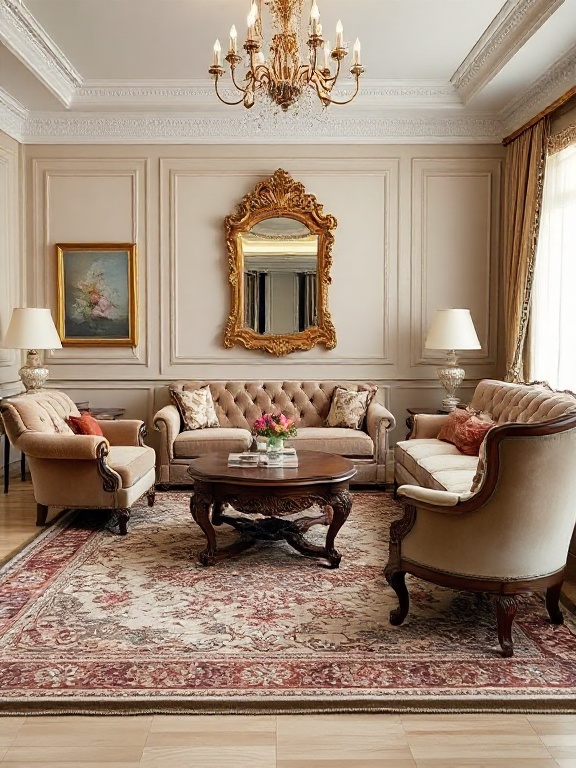Creating a living room that feels both timeless and inviting is one of the most rewarding design goals I work on with clients. While modern interiors often highlight sleek minimalism, vintage-inspired living rooms bring a certain depth, warmth, and character that simply cannot be replicated with new furniture alone. Vintage design blends history, craftsmanship, and artistry into everyday living, allowing a space to feel lived-in while still maintaining elegance.
When someone steps into a vintage-inspired living room, they should immediately feel the presence of thoughtful details—whether it’s the charm of an antique chair, the softness of a well-worn rug, or the allure of a chandelier casting warm light across the room. Achieving this look doesn’t necessarily mean filling your home with old pieces. Instead, it’s about balancing carefully chosen vintage accents with modern comfort to create an atmosphere that feels authentic and elegant.
Vintage-inspired elegance is not just about aesthetics—it’s about storytelling. Each item, from a gilded mirror to a velvet sofa, has the potential to carry history into your space. This blend of narrative and style is what makes the living room the perfect canvas for vintage elegance.
What Makes Vintage-Inspired Living Rooms Elegant?
In my experience, the elegance of a vintage-inspired living room lies in the balance between the old and the new. It’s about knowing which pieces to highlight and how to combine them so the room feels curated, not cluttered. Elegance in this style is less about being flashy and more about creating a sense of quiet sophistication through textures, colors, and carefully chosen statement elements.
The first element that defines vintage-inspired elegance is craftsmanship. Many vintage pieces were handmade or designed with a level of detail that is rare in mass-produced furniture today. When these items are introduced into a living room, they instantly elevate the space. From hand-carved wood to ornate moldings, the workmanship itself becomes a focal point.
Another defining aspect is the use of timeless color palettes. Muted shades like soft creams, dusty blues, sage greens, and warm browns create a sense of calm while still providing visual richness. Paired with layered textiles such as velvet cushions, lace curtains, or patterned area rugs, these colors help transform a living room into a cozy yet refined retreat.
Lastly, vintage-inspired elegance thrives on details. Small touches like brass hardware, crystal doorknobs, embroidered throw pillows, or a collection of framed black-and-white photographs contribute to the overall atmosphere. These finishing elements give the space personality and a sense of history that feels both inviting and refined.
Classic Antique Furniture Pairings
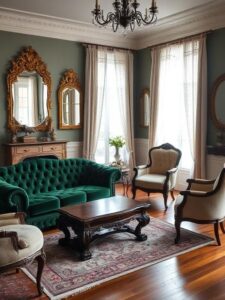
When I design a vintage-inspired living room, I always start with the furniture. Large pieces—sofas, armchairs, coffee tables, and cabinets—set the tone of the entire space. Choosing the right furniture doesn’t mean you need a room filled with antiques, but one or two standout pieces can completely transform the energy of the room.
For example, a tufted Chesterfield sofa upholstered in rich leather or velvet immediately anchors the living room with elegance. Pairing it with a delicate wooden coffee table featuring carved legs creates a beautiful balance between sturdiness and refinement. If you have a smaller space, consider a French-style armchair with curved arms and cabriole legs—these pieces are not only comfortable but also incredibly elegant in form.
Mixing antique furniture with more contemporary items is also an effective way to keep the room feeling fresh. A vintage sideboard topped with a sleek modern lamp creates contrast that enhances both styles. Similarly, pairing an ornate wooden mirror with a clean-lined sofa prevents the room from feeling like a museum.
When choosing furniture, think about the finishes and fabrics. Woods like mahogany, walnut, or oak bring warmth and depth, while fabrics like velvet, brocade, or linen highlight vintage charm. Even a single reupholstered piece can serve as the centerpiece of a vintage-inspired living room, giving your space instant personality.
Soft Color Palettes with Vintage Accents
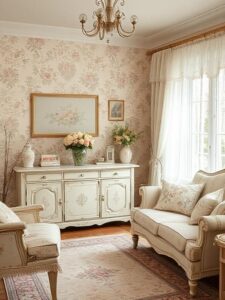
Color plays an essential role in bringing out the elegance of vintage-inspired living rooms. Unlike bold contemporary designs, vintage palettes lean toward softer and more muted shades, creating a sense of harmony and comfort. I often recommend colors that have a slightly faded or weathered quality, as though they’ve been gently aged over time.
Shades like cream, ivory, and beige form a timeless backdrop, while muted pastels such as dusty rose, powder blue, or sage green add depth without overwhelming the space. These colors work especially well when layered with natural wood tones, gold accents, or darker hues like navy or deep burgundy for contrast.
Adding vintage-inspired accents through textiles and accessories is another effective way to reinforce the palette. A Persian-style rug in soft neutrals, lace or sheer curtains, or embroidered cushions can subtly tie the colors of the room together. Even small decorative elements such as ceramic vases, distressed picture frames, or vintage-inspired wallpaper with floral or damask patterns can help create a cohesive look.
One of my favorite techniques is to introduce patina—those surfaces that show gentle signs of age. Whether it’s a slightly weathered wooden chest or a metal side table with a soft tarnish, these elements add authenticity and charm. Paired with soft color palettes, they bring an understated elegance that feels effortless and timeless.
Statement Lighting Fixtures
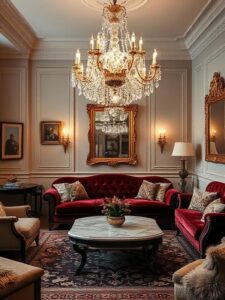
Lighting is one of the most powerful ways to set the mood in a living room, and vintage-inspired spaces benefit greatly from statement fixtures. I’ve found that a chandelier, whether crystal, wrought iron, or brass, immediately transforms a room with elegance. It doesn’t have to be oversized—sometimes a smaller, delicately detailed chandelier can create just as much impact as a grand one.
For a softer glow, consider pairing vintage chandeliers with wall sconces. Sconces with ornate detailing or frosted glass shades provide warm, ambient lighting that complements the main fixture. Placing them on either side of a fireplace or mirror also adds balance to the room.
Table and floor lamps should not be overlooked. A lamp with a pleated shade or stained-glass detailing not only provides functional lighting but also reinforces the vintage theme. The key is to layer your lighting: a mix of overhead, task, and accent lighting ensures the room feels cozy and dynamic at the same time.
Beyond functionality, lighting fixtures act as jewelry for the living room. The right piece draws attention upward, highlights architectural details, and adds an unmistakable air of refinement. When chosen thoughtfully, lighting becomes more than just illumination—it becomes part of the decor’s story.
Elegant Vintage-Inspired Textiles and Patterns
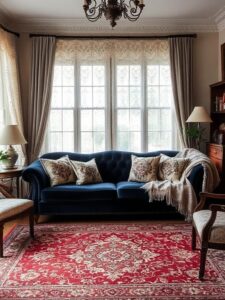
Textiles are where vintage-inspired living rooms truly come alive. They soften the space, add depth, and bring a sense of warmth that is essential to creating elegance. In my projects, I always layer multiple fabrics and patterns to achieve a rich, lived-in feel.
Velvet is a staple for vintage design. A velvet sofa, ottoman, or even accent pillows can make the room feel instantly more sophisticated. Pairing velvet with lighter fabrics such as linen or cotton prevents the look from becoming too heavy.
Patterns are equally important. Florals, damask, and paisley all carry vintage charm, while stripes or checks can balance the overall look. These patterns work beautifully on upholstery, curtains, and area rugs. Even a single patterned throw blanket can shift the atmosphere of a living room toward elegance.
Rugs are especially powerful in vintage-inspired spaces. Persian-style rugs with intricate patterns and muted tones anchor the room and tie all elements together. Layering a smaller patterned rug over a larger neutral one is another way to create texture and dimension.
When working with textiles, don’t forget about trims and finishes. Tassels on curtains, embroidered edges on cushions, or fringed throws all contribute to the sense of refinement. These small details often go unnoticed at first glance, but they add the depth that makes a room feel thoughtfully designed.
Mixing Modern Comfort with Vintage Charm
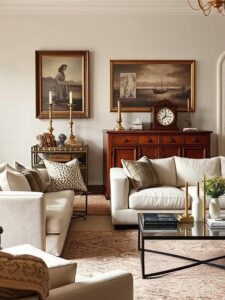
A common concern I hear from clients is that vintage-inspired living rooms might feel outdated or uncomfortable. The truth is, the most successful spaces combine the best of both worlds: modern comfort and vintage character.
Start with a modern foundation, such as a comfortable sofa with clean lines or a functional coffee table, and then layer in vintage accents. This approach keeps the room practical for everyday living while still capturing the elegance of the past.
For instance, a plush sectional can be paired with vintage side chairs to create balance. A modern media unit can be softened with antique decor on top, such as candlesticks, framed artwork, or a decorative clock. The contrast between sleek modern pieces and ornate vintage accents makes the room feel curated rather than themed.
The key is restraint. Too many vintage pieces can make the room feel dated, while too many modern items may lose the sense of elegance. Blending them thoughtfully allows the space to feel timeless, not stuck in one particular era.
This mix also ensures your living room is adaptable. As trends evolve, you can swap out certain accents without losing the vintage foundation. It’s a strategy I often recommend because it creates a space that grows with your lifestyle while maintaining its elegance.
Styling Tips to Perfect the Look
Styling is where all the pieces come together. Without the right styling, even the most beautiful furniture and textiles can feel disconnected. I always suggest focusing on three key areas when styling a vintage-inspired living room: balance, layering, and personalization.
Balance is essential. If you have a large, ornate mirror on one wall, balance it with softer elements across the room, such as a pair of armchairs or a grouping of framed prints. The goal is to keep the eye moving around the space without overwhelming it.
Layering is what gives vintage-inspired spaces their richness. Think about layers in terms of texture, color, and accessories. A sofa might hold a mix of velvet and linen pillows, while a coffee table may display stacked books, a decorative tray, and a vase of fresh flowers. Each layer adds to the overall story of the room.
Personalization is what makes the design uniquely yours. Family heirlooms, collected antiques, or framed photographs lend authenticity to the space. Vintage-inspired elegance doesn’t mean recreating a staged room—it means building a living space that reflects your history and taste.
Common Mistakes to Avoid in Vintage Decor
While vintage-inspired design offers endless possibilities, I often see the same mistakes repeated, and avoiding them is key to achieving true elegance.
The first mistake is overcrowding the room with too many vintage pieces. It’s tempting to fill a space with antiques, but doing so can make the room feel cluttered and heavy. Instead, focus on a few standout items and allow them to shine.
Another mistake is neglecting functionality. Vintage pieces can be beautiful, but they must also work with your lifestyle. A delicate antique chair may look stunning, but if it’s uncomfortable for daily use, it might not be the right choice for a primary seating area.
Finally, ignoring cohesion is a common pitfall. Mixing styles can be effective, but the room still needs a sense of harmony. Sticking to a cohesive color palette and repeating certain materials or finishes throughout the space ensures everything feels intentional.
By avoiding these mistakes, you not only preserve the elegance of your living room but also create a space that feels welcoming and balanced.
Final Touches That Elevate Elegance
Once the main furniture, colors, and textiles are in place, it’s the finishing details that truly bring vintage-inspired living rooms to life. Accessories and decor items are the final brushstrokes in your design.
Mirrors are one of my favorite final touches. An ornate gold or silver-framed mirror not only adds elegance but also reflects light, making the room feel brighter and more spacious. Placing one above a mantel or sofa creates a strong focal point.
Artwork is another way to elevate the space. Black-and-white photography, oil paintings, or botanical prints in vintage frames all work beautifully. Grouping smaller pieces into a gallery wall can add personality without overwhelming the room.
Don’t underestimate the power of greenery. Potted plants in ceramic or brass planters add life and vibrancy to the space, while fresh flowers in crystal vases bring seasonal beauty. Even a single bouquet of roses can shift the atmosphere toward romance and charm.
The final layer is scent. A softly scented candle, vintage-inspired diffuser, or even a fireplace can complete the experience, making the room not just visually elegant but also emotionally inviting.
Conclusion
Designing a vintage-inspired living room is about more than just decoration—it’s about creating a space that tells a story. Elegance is found in the details: the curve of an armchair, the softness of a velvet cushion, the glimmer of a chandelier. By blending antique furniture, soft color palettes, thoughtful textiles, and modern comforts, you can craft a living room that feels timeless and personal.
I always remind my clients that vintage-inspired design is not about replicating the past but reimagining it for the present. Each choice, from a single accessory to a major furniture piece, should reflect both elegance and personality. With the right balance, your living room can become a space that feels inviting, refined, and uniquely yours.

